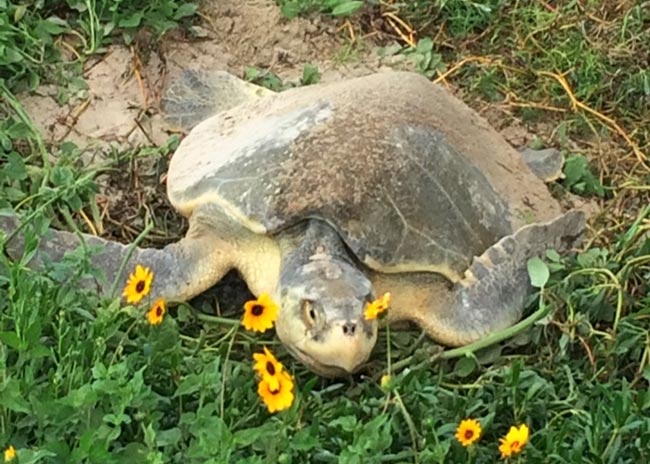Upper Texas Coast Sea Turtle Patrol Delaying Start of Patrol Season Amid Coronavirus Pandemic
April 29, 2020
Tweet
By Andréa Bolt, Communications Specialist, Division of Marketing & Communications
04/29/2020
Upon further recommendation from U.S. Fish and Wildlife Service (USFWS), officials from Texas A&M University at Galveston have decided to further delay the start of the Upper Texas Coast Sea Turtle Patrol.
The Upper Texas Coast Sea Turtle Patrol, a partnership with Texas A&M University-Galveston and Turtle Island Restoration Network (TIRN), is one of five sea turtle nesting programs along the Texas coast. All sea turtle patrol programs across the state have faced similar delays and constraints due to the COVID-19 pandemic.
Patrolling typically begins statewide between April 1 - July 15 each year. On the Upper Texas Coast, patrols were first delayed until the beginning of May; this will now be extended until the third week of May.
The USFWS and Texas Parks & Wildlife Department (TPWD) have come to an agreement to assist sea turtle patrol programs statewide, particularly on the Upper Texas Coast.
Staff from the Dickinson Marine Lab, one of TWPD's Coastal Fisheries Field Offices, will be patrolling the beaches for nesting and stranded turtles. These participating staff are also members of Texas Parks and Wildlife Department Kills and Spills Team (KAST), a group of biologists who investigate fish and wildlife kills resulting from pollution and natural events. KAST staff are trained to assess impacts to fish and wildlife resources and to determine the causes of events. As such, they are also equipped with personal protection equipment that protects them from chemical and oil spills, as well as the COVID-19 virus.
Further information regarding the start of patrolling is forthcoming.
03/26/2020
Texas A&M University at Galveston is delaying the start of Upper Texas Coast sea turtle patrol season due to strong recommendation from the U.S Fish and Wildlife Service (USFWS) in response to the COVID-19 and coronavirus pandemic.
The Upper Texas Coast is one of five sea turtle nesting projects along the Texas coast. The USFWS leads the statewide program in conjunction with Dr. Donna Shaver, head of the Division of Sea Turtle Science and Recovery at Padre Island National Seashore.
Sea turtle patrols begin their work statewide between April 1 and July 15 each year. Volunteers search and monitor long stretches of beach looking for signs of nesting.
Due to the northern location of the Upper Texas Coast, Kemp’s ridley sea turtles nest later here than in Mexico or South Texas, according to Dr. Christopher Marshall, Texas A&M-Galveston Department of Marine Biology professor and director of the Gulf Center for Sea Turtle Research. Marshall says nesting records show that over the last seven years, the first nest recorded on the Upper Texas Coast occurred in May.
Based upon these data and the global threats posed by the COVID-19 pandemic, the USFWS and the National Park Service strongly recommended that Texas A&M University-Galveston delay the Upper Texas Coast Sea Turtle Patrol season four to six weeks, until approximately May 1, 2020.
“The decision to delay the start of our patrols was a difficult one, but we must put human health and safety first. The timing of the delay is a good compromise since all of our nests over the past five years or more have been in May,” Marshall stated.
The decision to delay patrols was made as a measure to mitigate risks to volunteers, staff, students and the community during the COVID-19 pandemic.
Statewide meetings of all sea turtle patrol leads will occur every two weeks to reassess the situation.
For more information on Texas A&M-Galveston’s coronavirus and COVID-19 response, please visit: tamug.edu/COVID-19/.
###
Media contact:More:
Read more about Health & Environment
Read more about Marine Biology
Read more about Marine Sciences